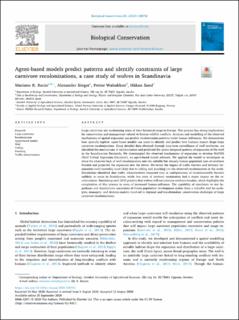| dc.contributor.author | Recio, Mariano R. | |
| dc.contributor.author | Singer, Alexander | |
| dc.contributor.author | Wabakken, Petter | |
| dc.contributor.author | Sand, Håkan | |
| dc.date.accessioned | 2021-07-02T15:50:11Z | |
| dc.date.available | 2021-07-02T15:50:11Z | |
| dc.date.created | 2020-10-13T22:13:53Z | |
| dc.date.issued | 2020 | |
| dc.identifier.citation | Biological Conservation. 2020, 251, 108752 | en_US |
| dc.identifier.issn | 0006-3207 | |
| dc.identifier.uri | https://hdl.handle.net/11250/2763147 | |
| dc.description.abstract | Large carnivores are recolonizing areas of their historical range in Europe. This process has strong implications for conservation and management related to human-wildlife conflicts. Analyses and modelling of the observed mechanisms of spatial expansion can predict recolonization patterns under human influences. We demonstrate how spatially-explicit, agent-based models can assist to identify and predict how humans impact shape large carnivore recolonizations. Using detailed data obtained through long-term surveillance of wolf territories, we identified the mechanisms of recolonization and predicted the spatio-temporal patterns of expansion of the wolf in the Scandinavian Peninsula. We disentangled the observed mechanisms of expansion to develop WolVES (Wolf Virtual Expansion Simulator), an agent-based model software. We applied the model to investigate in silico the observed lack of wolf recolonization into the suitable but densely human-populated area of southern Sweden and projected the expansion into the future. We tested the impact of traffic barriers and territory termination (wolf mortality most likely due to culling and poaching) on the observed recolonization in the south. Simulations identified that traffic infrastructures impacted only at configurations of insurmountable barriers unlikely to occur in Scandinavia, while low rates of territory termination had a major impact on the recolonization. Simulating until 2030 predicts that wolves will not colonize southern Sweden, which highlights the complexities of this process in areas of increased human-influence. The capability of simulators to test hypotheses and discriminate constraints of future population development makes them a valuable tool for ecologists, managers, and decision-makers involved in regional and transboundary conservation challenges of large carnivore recolonizations. | en_US |
| dc.language.iso | eng | en_US |
| dc.rights | Navngivelse 4.0 Internasjonal | * |
| dc.rights.uri | http://creativecommons.org/licenses/by/4.0/deed.no | * |
| dc.subject | large carnivores | en_US |
| dc.subject | recolonization | en_US |
| dc.subject | agent-based models | en_US |
| dc.subject | wolf | en_US |
| dc.subject | culling | en_US |
| dc.subject | poaching | en_US |
| dc.subject | traffic infrastructures | en_US |
| dc.title | Agent-based models predict patterns and identify constraints of large carnivore recolonizations, a case study of wolves in Scandinavia | en_US |
| dc.type | Peer reviewed | en_US |
| dc.type | Journal article | en_US |
| dc.description.version | publishedVersion | en_US |
| dc.subject.nsi | VDP::Matematikk og Naturvitenskap: 400::Zoologiske og botaniske fag: 480 | en_US |
| dc.source.volume | 251 | en_US |
| dc.source.journal | Biological Conservation | en_US |
| dc.identifier.doi | 10.1016/j.biocon.2020.108752 | |
| dc.identifier.cristin | 1839345 | |
| dc.source.articlenumber | 108752 | en_US |
| cristin.ispublished | true | |
| cristin.fulltext | original | |
| cristin.qualitycode | 2 | |

